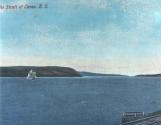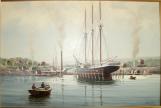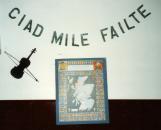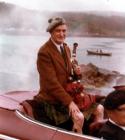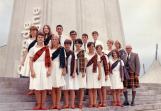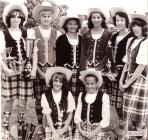2
ARTISTIC EXPRESSION AND CULTURE - The Strait of Canso, separating Cape Breton Island from mainland Nova Scotia, has always inspired artistic expression. This is a post card view looking north towards the area where the Canso Causeway would be constructed between 1952 and 1955.John Eliott Woolford's drawings of Cape Porcupine in the Gut of Canso, Plaister Cove (Port Hastings) and Ship Harbour (Port Hawkesbury) sketched in 1817 and 1818 are early visual pictures of the area.
4
J. FRANKLIN WRIGHT - A century and a half later world renowned marine artist J. Franklin Wright of Port Hawkesbury was painting sailing ships and historic maritime vessels with the Gut of Canso as a setting for some of them. His paintings show forested Cape Porcupine and the lighthouse of Balhache Point and many scenes of where he was born just across the harbour in Point Tupper as seen in this painting. (Used with permission of owner and artist- not to be copied)6
COMING OR GOING ACROSS THE CANSO CAUSEWAY - A recent painting by Marie Moore of Sydney entitled Going Home depicts a fishing boat and a sailboat, a train and cars heading east over the Causeway. The Canso Causeway is not only a permanent link with a road, bridge, railroad and canal between mainland Nova Scotia and Cape Breton Island but also a powerful symbol. To Islanders, if they are driving west, the Canso Causeway is often a sign of going down the road to find employment. If they are driving east, that curve across the water is a symbol of coming home.8
ONE HUNDRED THOUSAND WELCOMES - The strong feelings associated with "Homecoming" and "Leaving" are often expressed in the prose, poetry and music of the island. The Causeway is mentioned by name in a number of song titles and in many songs. Charlie MacKinnon's Causeway to the Isle is based on a poem by Lillian Crew Walsh. The Causeway Crossing (words by Albert MacDonald and music by John Gillis) certainly fits the "leaving but longing to stay" category as does the song Cape Breton's Crying (Russell Deveaux / Calum MacPhee / Glen, Brad and Keith MacNeil). The latter song was inspired by a phrase coined by Darrell Jones as he and his friends were leaving Cape Breton to return to work in Ontario and looking back saw the mist suspended over the Causeway. Arnold Sampson's song Home Again contains a more upbeat refrain Over the Causeway, up to the Margaree…I'm home again. I'll never leave this island anymore. Cape Breton's anthem The Island by Kenzie MacNeil has a line about the Causeway. Mickey McGivern's tune The Canso Causeway is written for the guitar.10
SANDY BOYD - The piano and the guitar are not the only instruments for which there are songs about the Causeway. The fiddle and the bagpipe have tunes too. Queensville resident Dan Hugh MacEachern's fiddle tune Canso Crossing Hornpipe was among the tunes published in his first book. A later book included the march Road to the Isle of New Scotland. Pipe Major Alexander "Sandy" Boyd not only composed a tune for the bagpipes entitled Crossing the Causeway but also was one of the pipers who marched across the Causeway on August 13, 1955. Legend says that he marched and piped despite a nail from the sole of his shoe sticking in his foot. In 1980, wearing a kilt and carrying his bagpipes, Sandy took no chances. At the age of 72, he rode across the Causeway on the back of a convertible for the 25th anniversary celebrations.12
PORT HAWKESBURY SCOTTISH COUNTRY DANCERS - In 1962, Nova Scotia Pulp Ltd. brought a large number of new families and their interests and talents to the Strait of Canso area. The Swedes and Norwegians introduced cross country skiing and started ski clubs. An indoor hockey rink was built and the mill sponsored annual Hockey tournaments. A curling club was built and tennis was started.In 1963, Arthur and Barbara Bilson introduced Scottish Country dancing to the children, teens and adults. In 1965, they took 20 teens on a three week dance tour to the Commonwealth Folk Arts in England, Scotland and Wales. Before leaving for London, they had a week-end tour of Montreal and later this group was invited to perform at Expo 1967 to celebrate Canada's Centennial.
In 1966, the Bilson's moved to the Bahamas. They did not want the Expo'67 tour cancelled, so they asked Mr. Rye Grant ( Manager of Bestwall Gypsum) to become chairman and chaperone. Sixteen year old dancer, Lois Urquhart of Port Hawkesbury passed her Royal Scottish Country Dance Teacher's Certificate so the classes and rehearsals continued. Guest dance teachers such as Jean Milligan, Gale Craig and June Shore came and helped these Port Hawkesbury dancers with technique and presentation for this world class performance. Highland dancers, Carolyn Mac Neil and Gerarda Mac Pherson from Antigonish, came to help the Port Hawkesbury Scottish Country dancers with Highland steps for the first performance of some of the McNabb Collection of Dances such as: Shepherd's Crook and Mac Donald of Sleat (discovered in a trunk from British Columbia).
Lois Urquhart Musselman went on to teach Scottish Country Dancing in Germany and Ontario during her school teaching days.
14
PORT HAWKESBURY HIGHLAND DANCERS - By 1973,Gerarda MacPherson of Antigonish began to teach highland dancing in Port Hawkesbury. The Strait of Canso area became known for the excellent talent in Highland Dancing and dance competition medals were and still are brought home from all over Canada, the United States and Scotland.Seen in this picture taken in 1980 in Alberta are: Back left- Dale MacDonald, Barbara Lohmann, Patti Ann MacLeod, Linda Dawe, Patricia MacEachern, Rosanna Campbell. Front- Kim Morgan and Robin Doyle.
Dale MacDonald continues to teach Highland Dancing in Port Hawkesbury thirty two years after the Port Hawkesbury Highland Dancers group was started in 1973.
